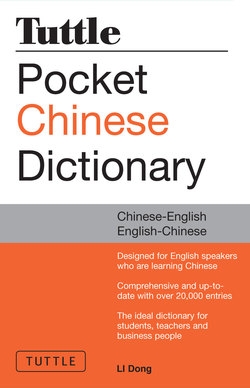Читать книгу Tuttle Pocket Chinese Dictionary - Li Dong - Страница 6
На сайте Литреса книга снята с продажи.
ОглавлениеHow to Use this Dictionary
This is a basic Chinese dictionary whose target user is the English-speaking language learner. It aims to put in concise form the basic and most frequently-encountered Chinese words a new learner to Chinese or one who has a basic understanding of Chinese is likely to look up.
The dictionary is conveniently divided into a Chinese-English section, and an English-Chinese section. All headwords are set in color, making the location of words very easy. Parts of speeches are given in small capitals (eg. V, N, ADJ, etc). All Chinese words are Simplified characters and they are accompanied by pinyin spellings, English translations for each word or phrase that are the nearest equivalent of the Chinese words.
For the Chinese-English section, words beginning with the same character are grouped together, and these follow alphabetically and according to the tonal structures – ie first tone, then second tone, and so on. For example:
kāi 开
kāicǎi 开采
kāichú 开除
kāidāo 开刀
kāifā 开发
kāifàng 开放
...
The same Chinese character with two or more different meanings will be considered as separate entries:
jiǎo 角1 N corner
jiǎo 角2 M. WD (Chinese currency)...
However, if the Chinese character has two different sounds, then each sound is treated as a distinct entry:
fēn 分 I V 1 divide 2 distribute 3 distinguish
fèn 分 N 1 component 2 limit
For Chinese words that have more than one word class, the differences in classes will be numbered separately, for example:
kùn 困 I V be stranded, be in a tough spot II ADJ sleepy
The List of Radicals (p ix) lists the radicals according to the number of strokes for each, and the number assigned to each radical. Use the radical number to look up the Radical Index (pp x–xxii). All characters under the same radical will be arranged according to the number of word strokes. Use the pinyin to locate the correct character in the dictionary.
List of Abbreviations Used
ADJ adjective
ADV adverb
CONJ conjunction
INTERJ interjection
M.WD measure word
MODAL V modal verb
N noun
NUM numeral
PT past tense
PP past participle
PREP preposition
PRON pronoun
V verb
